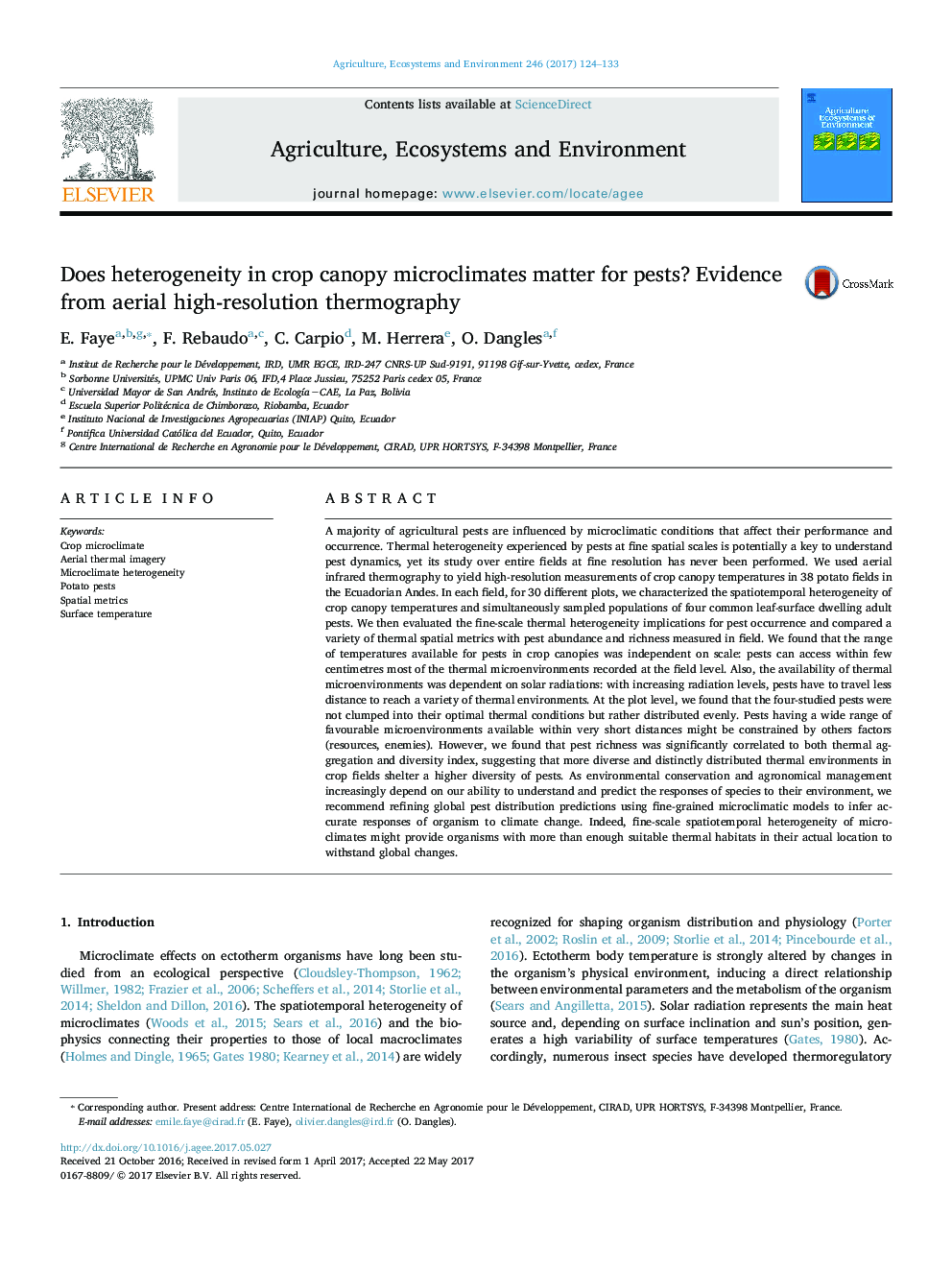| کد مقاله | کد نشریه | سال انتشار | مقاله انگلیسی | نسخه تمام متن |
|---|---|---|---|---|
| 5538036 | 1552006 | 2017 | 10 صفحه PDF | دانلود رایگان |
عنوان انگلیسی مقاله ISI
Does heterogeneity in crop canopy microclimates matter for pests? Evidence from aerial high-resolution thermography
ترجمه فارسی عنوان
آیا ناهمگونی در سایبان محصول میکروسکوپ مواد مهم برای آفات است؟ شواهد از ترموگرافی با رزولوشن بالا
دانلود مقاله + سفارش ترجمه
دانلود مقاله ISI انگلیسی
رایگان برای ایرانیان
کلمات کلیدی
میکرو کلم محصول، تصاویر گرمایی هوایی، ناهمگونی میکرو کلیم، آفات سیب زمینی، معیارهای مکانی دمای سطح،
ترجمه چکیده
اکثر آفات کشاورزی تحت تأثیر شرایط میکرو کلامی قرار دارند که بر عملکرد و وقوع آنها تأثیر می گذارد. ناهمگنی حرارتی که توسط آفات در مقیاس فضایی خوب تجربه شده است به طور بالقوه یک کلید برای درک پویایی آفات است، اما مطالعه آن بر روی تمام زمینه ها با وضوح خوب هرگز انجام نشده است. ما از ترموگرافی مادون قرمز هوا برای اندازه گیری وضوح با وضوح بالا از دماهای سایبان محصول در 38 میدان سیب زمینی در آند آندر اکوادور استفاده کردیم. در هر زمینه، برای 30 قطعه مختلف، ما مشخص شد که ناهمگنی فضایی شیب دار در دمای سحابی محصول و به طور همزمان جمعیتی از چهار گونه از آفات بالغ در سطح برگ معمولی را نشان می دهد. سپس ما مقادیر ناهمگنی گرمایی را برای وقوع آفات ارزیابی کردیم و انواع مختلف متریک های حرارتی را با فراوانی و غنی بودن آفات اندازه گیری کردیم. ما دریافتیم که محدوده دمایی موجود برای آفات در کاناپه های کاشت در مقیاس مستقل است: آفات می توانند در چند سانتی متر بیشترین میکرو محیط های حرارتی ثبت شده در سطح زمین را داشته باشند. همچنین دسترسی به میکرو محیط های حرارتی به تابش خورشید بستگی داشت: با افزایش سطح تابش، آفات مجبور به مسافرت کمتری می شدند تا به محیط های مختلف حرارتی برسند. در سطح طرح، ما دریافتیم که آفات چهار مطالعه شده به شرایط حرارتی مطلوبشان، اما نه به طور مساوی توزیع شده اند. آفات دارای طیف وسیعی از میکرو محیط مطلوب موجود در فواصل بسیار کوتاه ممکن است توسط عوامل دیگر (منابع، دشمنان) محدود شوند. با این حال، ما دریافتیم که غنی بودن آفات به طور قابل توجهی با هم گرمادهی و شاخص تنوع حرارت مرتبط است، و این نشان می دهد که محیط های گرمای بیش تر و متمایز در مزارع کشاورزی دارای تنوع بیشتری از آفات هستند. به عنوان حفظ محیط زیست و مدیریت زراعی به طور فزاینده ای به توانایی ما در درک و پیش بینی پاسخ های گونه ها به محیط آنها بستگی دارد، ما توصیه می کنیم پیش بینی های توزیع جهانی آفت را با استفاده از مدل های میکرو کالیوسی ریز دانه ای برای ارزیابی پاسخ دقیق ارگانیزم به تغییرات آب و هوایی. در واقع، ناهمگونی فصیحانه ای در مقیاس نازک میکروکلیمات ممکن است ارگانیسم هایی را با زیستگاههای حرارتی مناسب در مکان واقعی خود برای مقاومت در برابر تغییرات جهانی فراهم کند.
موضوعات مرتبط
علوم زیستی و بیوفناوری
علوم کشاورزی و بیولوژیک
علوم زراعت و اصلاح نباتات
چکیده انگلیسی
A majority of agricultural pests are influenced by microclimatic conditions that affect their performance and occurrence. Thermal heterogeneity experienced by pests at fine spatial scales is potentially a key to understand pest dynamics, yet its study over entire fields at fine resolution has never been performed. We used aerial infrared thermography to yield high-resolution measurements of crop canopy temperatures in 38 potato fields in the Ecuadorian Andes. In each field, for 30 different plots, we characterized the spatiotemporal heterogeneity of crop canopy temperatures and simultaneously sampled populations of four common leaf-surface dwelling adult pests. We then evaluated the fine-scale thermal heterogeneity implications for pest occurrence and compared a variety of thermal spatial metrics with pest abundance and richness measured in field. We found that the range of temperatures available for pests in crop canopies was independent on scale: pests can access within few centimetres most of the thermal microenvironments recorded at the field level. Also, the availability of thermal microenvironments was dependent on solar radiations: with increasing radiation levels, pests have to travel less distance to reach a variety of thermal environments. At the plot level, we found that the four-studied pests were not clumped into their optimal thermal conditions but rather distributed evenly. Pests having a wide range of favourable microenvironments available within very short distances might be constrained by others factors (resources, enemies). However, we found that pest richness was significantly correlated to both thermal aggregation and diversity index, suggesting that more diverse and distinctly distributed thermal environments in crop fields shelter a higher diversity of pests. As environmental conservation and agronomical management increasingly depend on our ability to understand and predict the responses of species to their environment, we recommend refining global pest distribution predictions using fine-grained microclimatic models to infer accurate responses of organism to climate change. Indeed, fine-scale spatiotemporal heterogeneity of microclimates might provide organisms with more than enough suitable thermal habitats in their actual location to withstand global changes.
ناشر
Database: Elsevier - ScienceDirect (ساینس دایرکت)
Journal: Agriculture, Ecosystems & Environment - Volume 246, 1 August 2017, Pages 124-133
Journal: Agriculture, Ecosystems & Environment - Volume 246, 1 August 2017, Pages 124-133
نویسندگان
E. Faye, F. Rebaudo, C. Carpio, M. Herrera, O. Dangles,
